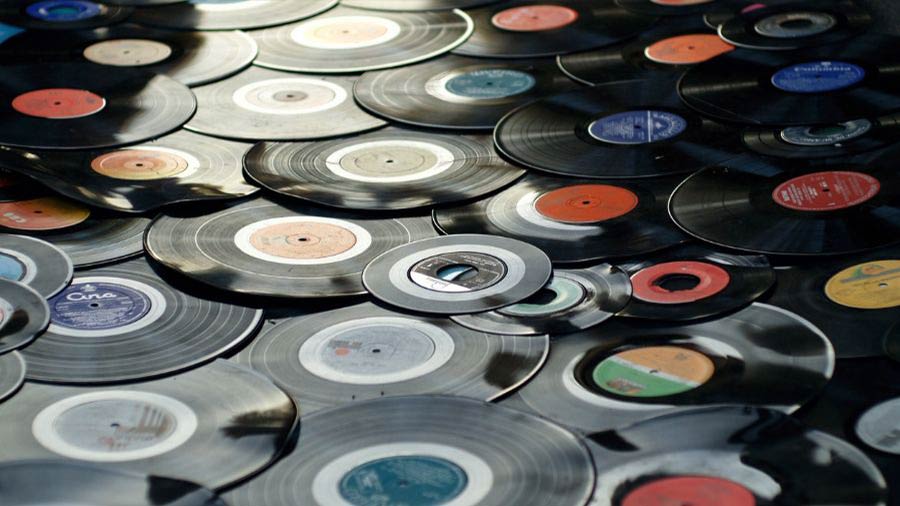Music is a universal language that echoes with people across the globe. Each genre carries its unique style, weaving stories and emotions through distinct rhythms and melodies. Let's discover the characteristics and essence of some popular genres. Whilst this blog is titled every genre of music, it is impossible as new genres are always being invented but we will write about as many as possible and where they originated and what distinctive traits of the genre involves.
1. Dance Music
Dance music is more than just a genre; it's an invitation to move, groove, and let loose. Rooted in electronic sounds, dance music encompasses subgenres like techno, house, and trance. It's the heartbeat of clubs and festivals, creating an atmosphere where beats unite people in a shared celebration of rhythm and unity.
2. Hip Hop
Hip-hop emerged as a cultural movement, shaping how we express ourselves through music, art, and language. Born in the Bronx in the 1970s, this genre combines rhythmic beats with powerful lyrics, narrating stories of urban life, social struggles, and personal triumphs. It's a dynamic force that continues to influence and redefine contemporary culture.
3. Disco
The disco era of the '70s was a dazzling time of glamour and dance-centric music. With its four-on-the-floor beats, orchestral arrangements, and soulful vocals, disco created the soundtrack for a glittering nightlife. Its influence laid the foundation for the electronic dance music (EDM) movement.
4. Drum and Bass
Drum and bass (D&B) emerged from the UK rave scene, offering a experience characterized by fast-paced beats and deep basslines. This genre, with its intricate drum patterns, has evolved to produce sub-genres that shape the future of music.
5. Trap
Trap music, featuring heavy beats, hi-hats, and intense synths, originated in the southern United States. Born from hip-hop but paving its way, the trap has become dominant in contemporary music. Its influence echoes across genres, shaping the landscape of popular and electronic music.
6. Rap

Rap, an integral part of hip-hop culture, focuses on rhythmic and rhyming speech. Serving as a platform for lyrical expression, rap addresses social issues, personal experiences, and storytelling. It has evolved into a global phenomenon.
7. Funk
Funk music, born in the 1960s, is all about infectious grooves and syncopated beats. With solid bass lines, brass sections, and soulful vocals, funk encourages listeners to move and feel the rhythm. Its influence extends across genres, leaving an indelible mark on the history of music.
8. Jazz
Jazz, a genre born in the late 19th century, celebrates improvisation and unique rhythmic patterns. With its various subgenres like swing, bebop, and fusion, jazz showcases technical prowess and artistic expression. Jazz musicians continue to push boundaries, reinventing the musical landscape with their creativity.
9. Classical
Classical music, rooted in centuries of tradition, offers compositions with intricate melodies and harmonies. From the Baroque to the Contemporary period, classical music is performed by orchestras, and soloists. It emphasizes formal structures and artistic expression, creating timeless masterpieces that resonate across generations.
10. Pop
Pop music, short for popular, is designed for mass appeal. Pop music dominates the global charts with its catchy melodies and relatable lyrics. It seamlessly incorporates elements from various genres.
11. Rock
Rock music originated in the United States in the 1950s. It evolved from a combination of various musical styles, including rhythm and blues, country, gospel, and jazz. Rock music is characterized by its prominent use of electric guitars, bass guitars, drums, and often keyboards or other instruments. The genre gained widespread popularity in the mid-20th century and has since diversified into numerous subgenres, including classic rock, alternative rock, punk rock, and heavy metal, among others. Rock music has had a profound cultural and social impact, influencing fashion, attitudes, and youth culture around the world. It remains one of the most enduring and influential genres of popular music.
12. Electronic
Electronic music originated in various countries, with its roots tracing back to the mid-20th century. However, its development as a distinct genre emerged prominently in the United States and Europe during the late 20th century. Electronic music utilizes electronic devices and technology to create and manipulate sound. It encompasses a wide range of styles and subgenres, including techno, house, trance, drum and bass, and ambient, among others. The use of synthesizers, drum machines, samplers, and digital recording techniques is central to electronic music production. Over the decades, electronic music has become a dominant force in popular music and has significantly influenced modern music production techniques and styles across the globe.
13. Blues

The blues originated in the United States during the late 19th century, particularly in the Mississippi Delta region. It developed from a combination of African musical traditions, field hollers, work songs, spirituals, and European folk music. Blues music is characterized by its distinctive chord progressions, call-and-response patterns, and expressive vocal style. It typically features lyrics that express themes of struggle, hardship, and resilience. Blues musicians often accompany themselves on acoustic or electric guitars, harmonicas, and other instruments. Over time, the blues has evolved into various subgenres, including Delta blues, Chicago blues, and Texas blues, among others. It has had a profound influence on many other genres of music, including rock and roll, jazz, and rhythm and blues.
14. Country
Country music originated in the Southern United States in the early 20th century, particularly in the rural regions of the Southeast. It evolved from a blend of folk music, traditional ballads, and musical influences brought by European immigrants, particularly from the British Isles. Country music is characterized by its simple melodies, heartfelt lyrics, and emphasis on storytelling, often revolving around themes such as love, heartache, rural life, and patriotism. Instruments commonly used in country music include acoustic and electric guitars, fiddles, banjos, and steel guitars. Over time, country music has diversified into various subgenres, including traditional country, outlaw country, bluegrass, and country pop, among others. It has become one of the most popular and enduring genres of American music, with a global fan base and influence on other musical styles.
15. Reggae

Reggae music originated in Jamaica during the late 1960s. It emerged from earlier Jamaican music styles such as ska and rocksteady, as well as influences from American rhythm and blues and Caribbean calypso music. Reggae is characterized by its offbeat rhythm, syncopated guitar and keyboard accents, and emphasis on the "one drop" rhythm pattern. The genre often features socially conscious lyrics addressing themes such as social justice, love, and spirituality. Notable instruments in reggae music include the bass guitar, drums, and various percussion instruments such as the bongos and congas. Reggae became internationally popular in the 1970s through the music of artists like Bob Marley and the Wailers, and it has since influenced numerous other musical genres worldwide.
16. R&B/Soul
R&B, or rhythm and blues, originated in the United States in the late 1940s. It evolved from African American musical styles, including blues, jazz, and gospel music. R&B is characterized by its soulful vocals, intricate rhythms, and emotional lyrics often focusing on themes of love, relationships, and social issues. The genre typically features a combination of vocals, accompanied by instruments such as electric guitars, pianos, drums, and brass instruments. R&B has undergone various transformations over the decades, giving rise to subgenres such as soul, funk, and contemporary R&B. It has had a significant impact on popular music worldwide, influencing genres such as rock and roll, pop, hip-hop, and electronic music.
17. Folk
Folk music originated in various countries around the world, with its roots deeply embedded in the traditional music of rural communities. It has been present for centuries, evolving over time and adapting to different cultural contexts. However, its modern form, often associated with the acoustic revival of the mid-20th century, particularly in the United States and the United Kingdom, gained prominence. Folk music is characterized by its storytelling nature, often focusing on themes such as love, nature, social issues, and historical events. It typically features simple melodies and chord progressions, played on acoustic instruments such as guitars, banjos, fiddles, and mandolins. Folk music has a rich oral tradition, with songs passed down through generations and often evolving through reinterpretation and adaptation. It has had a profound influence on other genres, including rock, country, and blues, and continues to thrive in various forms around the world.
18. Metal

Metal music originated primarily in the United Kingdom and the United States during the late 1960s and early 1970s. It evolved from various musical styles, including blues rock, hard rock, and psychedelic rock, with bands such as Black Sabbath, Led Zeppelin, and Deep Purple pioneering the genre. Metal music is characterized by its heavy and distorted guitar sound, fast-paced rhythms, and powerful vocals. It often features complex song structures, virtuosic instrumentation, and themes related to power, rebellion, and the darker aspects of human experience. Metal encompasses numerous subgenres, including heavy metal, thrash metal, death metal, black metal, and many others, each with its own unique characteristics and fan base. Metal music has a dedicated global following and continues to evolve and diversify, influencing other genres of music and popular culture.
19. Punk
Punk music originated primarily in the United States and the United Kingdom during the mid-1970s. It emerged as a rebellious response to the mainstream music industry and social and political conditions of the time. Punk is characterized by its raw and aggressive sound, short and fast-paced songs, and DIY ethos. It often features simple chord progressions, stripped-down instrumentation, and confrontational lyrics that address social and political issues, as well as personal struggles. Punk music emphasizes authenticity, individuality, and anti-establishment sentiments. Bands such as The Ramones, The Sex Pistols, and The Clash were among the early pioneers of the genre. Punk music has since diversified into various subgenres, including hardcore punk, pop punk, and punk rock, among others, each with its own distinct characteristics and subculture.
20. K-Pop
K-Pop, short for Korean Pop, originated in South Korea in the early 1990s. It emerged as a fusion of various musical styles, including pop, hip-hop, R&B, and electronic dance music (EDM). K-Pop is characterized by its catchy melodies, synchronized dance routines, visually appealing music videos, and often incorporates elements of Korean culture. It gained international popularity in the late 2000s and has since become a global phenomenon, with K-Pop groups and artists gaining dedicated fanbases around the world. The genre continues to evolve and innovate, with new acts constantly emerging and pushing boundaries in both music and visual presentation. K-Pop has become synonymous with South Korean popular culture and plays a significant role in shaping global music trends.
21. Gospel
Gospel music originated in the United States during the late 19th and early 20th centuries, primarily within African American Christian communities. It evolved from a blend of African spirituals, hymns, and blues music, with influences from jazz and soul. Gospel music is deeply rooted in Christian faith and spirituality, often featuring lyrics that express devotion, praise, and thanksgiving to God. It is characterized by its powerful vocal performances, rich harmonies, and dynamic arrangements, typically accompanied by piano, organ, and sometimes choir or other instruments. Gospel music serves both as a form of worship and as a means of spreading the Christian message. It has had a significant impact on popular music, influencing various genres such as soul, R&B, and rock and roll. Today, gospel music encompasses a wide range of styles, including traditional gospel, contemporary gospel, and gospel jazz, among others.
22. World
World music is a genre that does not have a specific country of origin, as it encompasses a wide range of musical styles and traditions from around the world. It emerged as a category in the late 20th century to encompass traditional and contemporary music from various cultures and regions. World music includes folk music, traditional music, indigenous music, and fusion genres that blend elements from different cultures. It celebrates cultural diversity, heritage, and musical expression from all corners of the globe. World music often features a wide array of instruments, vocal styles, and rhythmic patterns unique to each culture, offering listeners a glimpse into global musical traditions.
23. Experimental/Avant-garde
Experimental or avant-garde music is a genre that defies easy categorization in terms of country of origin or specific era. It emerged in various forms across different countries and time periods, with roots in the early 20th century avant-garde movements in Europe and the United States. Experimental music challenges traditional notions of melody, harmony, rhythm, and structure, often incorporating unconventional techniques, electronic sounds, and non-traditional instruments. It prioritizes innovation, exploration, and pushing the boundaries of what is considered "music." Experimental music can range from abstract soundscapes to intricate compositions, and it often explores concepts such as randomness, improvisation, and aleatoric music. Artists within the genre include pioneers like John Cage, Karlheinz Stockhausen, and Pierre Schaeffer, as well as contemporary experimentalists continuing to push the boundaries of musical expression.
24. Indie
Indie music, short for independent music, originated primarily in the United Kingdom and the United States during the 1980s and 1990s. It emerged as a response to the commercialization of the mainstream music industry, with artists and bands seeking creative freedom and autonomy outside of major record labels. Indie music is characterized by its DIY ethos, with artists often self-producing and releasing their music through independent record labels or self-publishing platforms. It encompasses a wide range of styles, including alternative rock, indie pop, indie folk, and more experimental genres. Indie music values authenticity, creativity, and individuality, and it often emphasizes artistic expression over commercial success. Artists associated with indie music include bands like The Smiths, Pixies, and Youth, as well as contemporary indie artists like Arcade Fire, Vampire Weekend, and Tame Impala.
25. Alternative
The alternative music genre originated primarily in the United Kingdom and the United States during the late 1970s and early 1980s. It emerged as an experimental response to the mainstream music of the time, offering an alternative to conventional pop and rock styles. Alternative music encompasses a wide range of subgenres, including alternative rock, indie rock, grunge, shoegaze, and post-punk, among others. It is characterized by its non-conformist attitude, influences, and willingness to explore unconventional sounds and themes. Alternative artists often prioritize artistic integrity and authenticity, challenging traditional notions of commercial success. Notable bands and artists associated with alternative music include Nirvana, Radiohead, The Cure, Pixies, and R.E.M., among many others.
26. EDM (Electronic Dance Music)
Electronic Dance Music (EDM) originated primarily in the United States and Europe during the late 20th century, with roots tracing back to the disco and electronic music scenes of the 1970s and 1980s. It gained prominence in the 1990s and early 2000s with the rise of underground rave culture and the emergence of electronic music festivals. EDM encompasses a wide range of electronic music styles, including house, techno, trance, dubstep, and drum and bass, among others. It is characterized by its use of synthesizers, drum machines, and computer software to create rhythmic and often repetitive beats, as well as intricate soundscapes and energetic melodies. EDM is closely associated with club culture, dance parties, and high-energy live performances, and it has become a global phenomenon with a massive fan base around the world. Famous EDM DJs and producers include pioneers like Daft Punk, The Chemical Brothers, and Fatboy Slim, as well as contemporary artists like Avicii, Calvin Harris, and Skrillex.
27. Techno

Techno music originated in the city of Detroit, Michigan, United States, during the early 1980s. It emerged as a distinct genre from the electronic music scene, with roots in the industrial, funk, and electro music styles of the time. Techno is characterized by its repetitive beats, synthesized melodies, and futuristic soundscapes, often created using drum machines, synthesizers, and sequencers. The genre is known for its minimalistic approach to composition, focusing on driving rhythms and hypnotic patterns that are designed to create a danceable experience. Techno music played a significant role in shaping the underground club culture of the 1980s and 1990s, and it continues to be a popular genre in electronic music today, influencing a wide range of artists and styles around the world. Some pioneering techno artists include Juan Atkins, Derrick May, and Kevin Saunderson, collectively known as the Belleville Three, as well as contemporary DJs and producers like Carl Cox, Richie Hawtin, and Nina Kraviz.
28. House
House music originated in Chicago, Illinois, United States, during the early 1980s. It emerged from the city's underground club scene, particularly at venues like The Warehouse, hence the name "house" music. House music is characterized by its four-on-the-floor beat, which features a kick drum on every beat, along with synthesized basslines, electronic percussion, and soulful vocals. The genre is influenced by various music styles, including disco, funk, and electronic music. House music is known for its uplifting and infectious rhythms, as well as its emphasis on repetitive grooves and melodic hooks. It quickly gained popularity in nightclubs and dance parties around the world, becoming a dominant force in electronic dance music culture. Notable subgenres of house music include deep house, acid house, progressive house, and tech house, among others. Some pioneering figures in house music include Frankie Knuckles, Larry Heard (Mr. Fingers), and Marshall Jefferson, who are often referred to as the "godfathers" of house music.
29. Trance
Trance music originated in Germany during the early 1990s. It emerged from the electronic dance music scene, particularly in Frankfurt and Berlin. Trance is characterized by its repetitive beats, melodic synthesizer sequences, and atmospheric soundscapes. The genre often features a tempo range of 125 to 150 beats per minute, creating a hypnotic and euphoric experience for listeners. Trance music is known for its build-ups and breakdowns, where the energy of the track gradually increases before reaching a climactic peak. It is often associated with themes of spirituality, journey, and transcendence, with many tracks featuring ethereal vocal samples or uplifting melodies. Trance gained widespread popularity in the late 1990s and early 2000s, becoming a staple genre in electronic music festivals and clubs around the world. It has since evolved into various subgenres, including progressive trance, uplifting trance, and psytrance. Some pioneering trance artists include Paul van Dyk, Armin van Buuren, and Tiësto.
30. Dubstep

Dubstep originated in the United Kingdom during the late 1990s and early 2000s, primarily in London. It emerged from the UK garage and dub music scenes, drawing influences from genres like drum and bass, dub reggae, and 2-step garage. Dubstep is characterized by its heavy basslines, syncopated rhythms, and sparse arrangements. The genre often features "wobble" basslines, which are produced using synthesizers and manipulated through modulation techniques like LFO (low-frequency oscillation). Dubstep tracks typically have a tempo ranging from 138 to 142 beats per minute, although variations exist. The sound of dubstep is gritty and dark, with emphasis on sub-bass frequencies and experimental sound design. It gained mainstream popularity in the late 2000s and early 2010s, with artists like Skream, Benga, and Burial among the genre's pioneers. Dubstep has since diversified into various subgenres and influenced the development of electronic dance music worldwide.
31. Ambient
Ambient music originated in the United Kingdom during the 1970s. It emerged as a genre that focused on creating atmospheric soundscapes. Ambient music often features slow tempos, repetitive patterns, and a minimalistic approach to composition. It draws influences from various musical traditions, including classical, electronic, and experimental music. Ambient music is characterized by its ethereal and introspective qualities, often evoking feelings of calmness, relaxation, and contemplation. Artists in the ambient genre frequently use synthesizers, electronic effects, and field recordings to create textured soundscapes. Some prominent figures in ambient music include Brian Eno, Harold Budd, and Tangerine Dream.
32. Trip-hop
Trip-hop originated in the United Kingdom during the early 1990s. It emerged as a fusion of electronic music, hip-hop, and various other genres like jazz, funk, and soul. The genre is characterized by its downtempo beats, atmospheric textures, and often features melancholic or introspective lyrics. Trip-hop artists typically incorporate elements of sampling, looping, and electronic production. It gained popularity in underground music scenes before reaching mainstream recognition in the mid-1990s. Trip-hop pioneers include artists like Massive Attack, Portishead, and Tricky, who helped define the genre's sound and aesthetic. Trip-hop continues to influence contemporary electronic and alternative music styles.
33. Grunge
Grunge originated in the United States, particularly in the Pacific Northwest region, during the mid-1980s to early 1990s. It is closely associated with the alternative rock scene of Seattle, Washington. Grunge music is characterized by its distorted guitar sound, angst-ridden lyrics, and heavy influence from punk rock and heavy metal. Bands like Nirvana, Pearl Jam, Soundgarden, and Alice in Chains are considered pioneers of the genre. Grunge gained mainstream popularity in the early 1990s, with the success of albums such as Nirvana's "Nevermind." The genre's raw and unpolished sound became emblematic of the disillusionment and dissatisfaction felt by many young people at the time. Grunge's impact on popular music and culture continues to be felt today.
34. Ska
Ska originated in Jamaica during the late 1950s. It is a genre characterized by its upbeat tempo, syncopated rhythm, and prominent brass section. Ska music evolved from Jamaican mento and calypso music, as well as American jazz and rhythm and blues. It gained popularity in Jamaica's music scene before spreading internationally, especially to the United Kingdom in the 1960s and later influencing the development of reggae and rocksteady. Ska experienced revivals in the late 1970s and 1990s, with bands like The Specials and Madness bringing the genre to new audiences. Today, ska continues to be celebrated for its infectious energy and danceable rhythms.
35. Reggaeton
Reggaeton originated in Puerto Rico in the late 1990s. It is a genre that blends Jamaican dancehall, hip hop, and Latin American music styles such as salsa and bomba. Reggaeton is characterized by its distinctive dembow rhythm, catchy melodies, and often explicit lyrics. The genre gained international popularity in the early 2000s, with artists like Daddy Yankee, Don Omar, and Tego Calderón leading the way. Reggaeton has since become a dominant force in Latin music, influencing numerous other genres and achieving global recognition.
36. Latin
The term "Latin music" encompasses a wide range of musical styles originating from Latin America, as well as music influenced by Latin American rhythms and culture. It includes genres such as salsa, cumbia, merengue, bachata, bossa nova, and more. Latin music has its roots in various countries across Latin America, including Cuba, Puerto Rico, Brazil, Mexico, and Colombia, among others. It has a rich history dating back centuries, blending indigenous, African, and European musical traditions. Latin music is known for its infectious rhythms, vibrant melodies, and passionate lyrics, and it has a significant influence on global music scenes.
37. Bossa Nova
Bossa nova originated in Brazil, particularly in the city of Rio de Janeiro, in the late 1950s and early 1960s. It emerged as a fusion of samba rhythms with jazz influences, characterized by its subtle melodies, sophisticated harmonies, and relaxed, laid-back style. Bossa nova became internationally popular in the 1960s, thanks to artists like João Gilberto, Antônio Carlos Jobim, and Astrud Gilberto. It is known for its smooth guitar playing, gentle percussion, and intimate vocal delivery. Bossa nova is often associated with romantic themes and beachside imagery, capturing the essence of Brazilian culture.
38. Flamenco
Flamenco originated in Spain, particularly in the Andalusian region, during the late 18th century. It is characterized by its passionate singing, intricate guitar playing, rhythmic handclaps, and expressive dance movements. Flamenco often explores themes of love, loss, and longing, and it is deeply ingrained in Spanish culture and heritage.
39. Tango

Tango originated in the working-class neighborhoods of Buenos Aires, Argentina, during the late 19th century. It emerged as a fusion of African, European, and indigenous influences. Tango music is known for its melancholic melodies, rhythmic complexity, and expressive lyrics, often exploring themes of love, passion, and nostalgia. Tango is also accompanied by a distinctive style of dance characterised by intricate footwork.
40. Salsa
Salsa originated in the Caribbean, primarily in Cuba, during the mid-20th century. It is a blend of various Afro-Cuban musical styles, including son, mambo, cha-cha-chá, and others. Salsa is characterized by its energetic rhythms, infectious melodies, and lively dance movements. Over time, it has become popular worldwide, particularly in Latin America and among Latin music globally.
41. Merengue
Merengue originated in the Dominican Republic in the 19th century. It's characterized by lively rhythms, syncopated beats, and energetic dance movements.
42. Mariachi
Mariachi originated in Mexico during the 19th century. It is characterized by its vibrant rhythms, energetic melodies, and the use of traditional Mexican instruments such as the violin, trumpet, guitar, and vihuela. Mariachi music often accompanies celebrations and events such as weddings, festivals, and holidays, and it is deeply ingrained in Mexican culture.
43. Cumbia
Cumbia originated in Colombia during the late 17th century. It is a lively and rhythmic dance music characterized by its repetitive beat and melodic patterns. Cumbia has since spread throughout Latin America, becoming popular in countries like Mexico and Argentina. It incorporates elements of indigenous, African, and European musical traditions, resulting in a vibrant genre that is celebrated for its infectious rhythm and danceability.
44. Bluegrass
Bluegrass music originated in the United States, particularly in the Appalachian region, during the early to mid-20th century. It emerged as a blend of various musical traditions, including Scottish, Irish, and English folk music, along with elements of African American blues and jazz. Bluegrass is characterized by its fast tempo, intricate instrumental solos, and close harmonies. It typically features acoustic instruments such as the banjo, fiddle, guitar, mandolin, and upright bass, and is known for its lively and energetic sound.
45. Zydeco
Zydeco originated in the United States, particularly in the Creole communities of southwest Louisiana in the mid-20th century. It blends elements of Cajun music with rhythm and blues, incorporating instruments like the accordion, washboard, and sometimes electric guitar. Zydeco is known for its lively and danceable rhythms, often played at festivals and gatherings in Louisiana and beyond.
46. Klezmer
Klezmer music originated in Eastern Europe, primarily among Jewish communities, during the late 19th century. It encompasses a blend of traditional folk tunes, dance melodies, and improvisations, often played at weddings and other celebratory occasions. Klezmer music features instruments such as the violin, clarinet, accordion, and sometimes trumpet or trombone. It carries influences from various cultures, including Romanian, Ukrainian, Polish, and Hungarian, reflecting the regions where Jewish communities lived.
47. J-Pop
J-Pop, short for Japanese Pop, originated in Japan in the 1990s and encompasses a wide range of musical styles, including pop, rock, hip-hop, and electronic music. It often features catchy melodies, upbeat rhythms, and colorful visuals in music videos. J-Pop has gained popularity both domestically and internationally, with artists like Hikaru Utada, Ayumi Hamasaki, and Arashi achieving widespread success.
48. P-Pop
Philippines, 2000s. P-Pop, short for Philippine Pop Music, is a genre originating from the Philippines, characterized by catchy melodies, upbeat rhythms, and often featuring boy bands or girl groups. It incorporates elements of pop, dance, and sometimes incorporates local musical influences and languages.
49. Bollywood

Originating in India during the early 20th century, Bollywood music is the soundtrack of Indian cinema, blending traditional Indian music with Western influences. It features vibrant melodies, rhythmic beats, and rich instrumentation, often accompanied by elaborate dance sequences in Indian films.
50. Celtic
Celtic music originated in Ireland, Scotland, and other Celtic regions of Europe during the medieval period. It encompasses traditional folk tunes, often featuring instruments like the fiddle, tin whistle, flute, and bagpipes. Characterized by its lively rhythms, intricate melodies, and storytelling lyrics, Celtic music has evolved over centuries and continues to be celebrated worldwide for its cultural significance and emotive qualities.
51. Americana
Americana music originated in the United States in the mid-20th century, drawing influences from various American musical traditions such as folk, country, blues, and rock. It emerged as a genre that celebrates American culture, history, and folklore through its lyrics and melodies. Americana often features acoustic instrumentation, heartfelt vocals, and storytelling lyrics that reflect on themes of love, loss, freedom, and the American experience. It has continued to evolve over the years, incorporating elements from other genres while maintaining its roots in traditional American music.
52. Baroque
Baroque music originated in Europe, primarily in Italy, during the 17th and early 18th centuries. It is characterized by its ornate melodies, elaborate harmonies, and intricate instrumentation, often featuring harpsichords, strings, and woodwinds. Baroque music is known for its dramatic and emotional expression, with composers such as Johann Sebastian Bach, George Frideric Handel, and Antonio Vivaldi among its prominent figures.
53. Orchestral
Orchestral music originated in Europe during the Renaissance and Baroque periods, evolving into its modern form during the Classical and Romantic eras. It involves the use of a large group of musicians playing various instruments under the direction of a conductor. Orchestral compositions often include symphonies, concertos, and overtures, and they are known for their rich harmonies, dynamic contrasts, and complex arrangements.
54. Chamber Music
Chamber music originated in Europe, particularly in Italy, during the late Renaissance and Baroque periods. It involves small groups of musicians performing in intimate settings, such as chambers or small rooms. Typically, chamber music is composed for one player per part, allowing each instrument to have a distinct voice.
55. Choral
Choral music originated in various regions around the world, with roots in ancient civilizations such as Greece and Rome. However, it gained prominence in Western Europe during the medieval and Renaissance periods, particularly in churches and cathedrals. Choral music involves singing by a group of singers, typically organized into different vocal parts like soprano, alto, tenor, and bass. It encompasses a wide range of styles, from sacred chants and hymns to secular compositions and modern arrangements.
56. Opera
Opera originated in Italy during the late 16th century. It is a form of musical theater in which a dramatic work is performed through a combination of music, singing, acting, and often elaborate stage sets and costumes. Operas typically feature arias, duets, and groups, and are usually performed by trained singers accompanied by an orchestra or instrumental. The stories told in operas cover a wide range of themes and genres, and they are often performed in their original languages, although translations are also common.
57. Operetta
Operetta originated in Europe, particularly in Austria and Germany, during the 19th century. It is a light opera genre that features spoken dialogue, catchy melodies, and comedic elements. Operetta often explores romantic and humorous themes and is known for its accessible and entertaining style, making it popular among audiences of various backgrounds.
58. Dixieland
Dixieland originated in the United States during the early 20th century, particularly in New Orleans, Louisiana. It is characterized by lively and improvised playing, often featuring a front line of trumpet, clarinet, and trombone, supported by a rhythm section of piano, banjo, drums, and double bass. Dixieland is known for its energetic rhythms, collective improvisation, and traditional jazz melodies.
59. Swing
Swing music originated in the United States during the 1930s and 1940s, particularly in African American communities. It is characterized by its lively rhythm, prominent use of brass instruments, and emphasis on improvisation. Swing became popular during the Big Band era and was often associated with dance styles like the Lindy Hop and the Jitterbug. It played a significant role in shaping American music and culture during the mid-20th century.
60. Bebop
Bebop originated in the United States in the early to mid-1940s. It emerged as a development of jazz, particularly in the cities of New York and Kansas City. Bebop is characterized by fast tempos, complex harmonies, and improvisation. It represented a departure from the simpler, danceable forms of jazz that preceded it and is known for its virtuosic instrumental performances and innovative rhythmic and harmonic structures.
61. Cool Jazz
Cool jazz originated in the United States in the mid-20th century. It emerged as a subgenre of jazz during the 1940s and 1950s, characterized by its laid-back, understated approach to improvisation and its use of smoother, more subdued tones compared to earlier jazz styles. Cool jazz often features intricate arrangements, a focus on melodic improvisation, and a relaxed, sophisticated aesthetic. Its origins can be traced to the West Coast jazz scene, particularly in California, but it also had influences from bebop and other contemporary jazz styles.
62. Free Jazz
United States, 1960s. Free jazz is a genre of experimental music that emerged in the 1960s, characterized by improvisation, unconventional structures, and a departure from traditional jazz norms such as chord changes and established song forms. It often emphasizes collective improvisation and encourages musicians to explore new territories, resulting in unpredictable and boundary-pushing compositions.
63. Acid Jazz
Acid jazz originated in the United Kingdom during the late 1980s and early 1990s. It emerged from the jazz and funk scenes and incorporates elements of jazz, funk, soul, and electronic music. Acid jazz is known for its groove-oriented beats, catchy melodies, and use of electronic instruments and samples. It often features improvisational elements and blends traditional jazz with modern electronic production techniques, creating a distinct and eclectic sound.
64. Smooth Jazz

Smooth jazz originated in the United States in the late 1960s and early 1970s. It emerged as a fusion of jazz, R&B, funk, and pop music, characterized by its laid-back, mellow sound and emphasis on melody and groove. Smooth jazz often features polished production, catchy melodies, and instrumental solos, creating a relaxing and soothing listening experience.
65. New Age
New Age music originated in the United States in the late 20th century. It emerged as a genre that encompasses a wide range of soothing and ambient sounds, often incorporating elements of electronic music, acoustic instruments, and nature sounds. It's characterized by its relaxing and meditative qualities, aiming to promote stress relief, relaxation, and spiritual well-being.
66. Ambient House
Ambient house originated in the United Kingdom in the late 1980s and early 1990s. It blends elements of ambient music with house beats, creating a relaxed yet danceable atmosphere.
67. Industrial
Originating in the late 1970s and early 1980s, primarily in the United Kingdom and United States, Industrial music is characterized by its harsh, experimental sounds, often incorporating elements of noise, electronic music, and distorted vocals. Bands like Throbbing Gristle and Cabaret Voltaire are considered pioneers of the genre.
68. Goth
Emerging from the post-punk scene in the late 1970s, Goth music has its roots in the United Kingdom. It features dark and atmospheric sounds, introspective lyrics, and a distinctive fashion style often associated with themes of romance, morbidity, and the macabre. Bands like Bauhaus and Siouxsie and the Banshees are influential in the genre.
69. New Wave
Originating in the late 1970s and early 1980s, New Wave music emerged primarily in the United Kingdom and United States as a response to punk rock. It incorporates elements of punk, electronic, and pop music, featuring synthesizers, catchy melodies, and a more polished sound. Bands like Blondie and Talking Heads are prominent in the New Wave movement.
70. Synth-pop
Originating in the late 1970s, particularly in the United Kingdom, Synth-pop (short for synthesizer pop) is characterized by its use of synthesizers, electronic beats, and catchy melodies. It became popular in the 1980s and influenced mainstream pop music. Bands like Depeche Mode and The Human League are key figures in the genre.
71. Shoegaze
Originating in the late 1980s and early 1990s, primarily in the United Kingdom, Shoegaze is characterized by its ethereal soundscapes, heavily distorted guitars, and whispered vocals. The genre got its name from the onstage behavior of bands who would stare down at their effects pedals while performing. Bands like My Bloody Valentine and Slowdive are notable in the Shoegaze scene.
72. Post-rock
Originating in the late 1980s and early 1990s, Post-rock emerged from various parts of the world, including the United States, United Kingdom, and Canada. It emphasizes instrumental compositions, experimental structures, and a focus on texture and atmosphere rather than traditional song structures. Bands like Godspeed You! Black Emperor and Mogwai are influential in the genre.
73. Math Rock
Originating in the late 1980s and early 1990s, Math Rock emerged primarily in the United States and Japan. It is characterized by complex and irregular rhythms, intricate guitar work, and unconventional song structures. Bands like Don Caballero and Hella are notable in the Math Rock scene.
74. Stoner Rock
Originating in the early 1990s, Stoner Rock emerged primarily in the United States, particularly in California. It combines elements of psychedelic rock, blues rock, and doom metal, featuring heavy, fuzzed-out guitar riffs and a laid-back, groovy rhythm. Bands like Kyuss and Sleep are prominent in the Stoner Rock genre.
75. Doom Metal
Originating in the late 1970s and early 1980s, Doom Metal emerged primarily in the United Kingdom. It is characterized by its slow tempo, heavy guitar riffs, and dark, introspective lyrics. The genre often explores themes of despair, depression, and the occult. Bands like Black Sabbath and Candlemass are influential in the Doom Metal scene.
76. Black Metal
Originating in the early to mid-1980s, Black Metal emerged primarily in Norway and other parts of Scandinavia. It is characterized by its fast tempos, shrieked vocals, and heavily distorted guitars. The genre often explores themes of paganism, nature, and anti-Christianity. Bands like Mayhem and Burzum are key figures in the Black Metal movement.
77. Death Metal
Originating in the mid-1980s, Death Metal emerged primarily in the United States and Europe. It is characterized by its aggressive, growled vocals, fast tempo, and complex guitar riffs. The genre often explores themes of gore, violence, and death. Bands like Death and Cannibal Corpse are influential in the Death Metal scene.
78. Power Metal
Originating in the mid-1980s, Power Metal emerged primarily in Europe, particularly in Germany and Scandinavia. It is characterized by its fast tempo, melodic guitar solos, and fantasy-themed lyrics. The genre often features epic storytelling and operatic vocals. Bands like Helloween and Blind Guardian are prominent in the Power Metal genre.
79. Nu Metal
Originating in the mid-1990s, Nu Metal emerged primarily in the United States. It is characterized by its fusion of heavy metal with elements of hip hop, funk, and alternative rock. The genre often features downtuned guitars, rapped or shouted vocals, and electronic elements. Bands like Korn and Limp Bizkit are notable in the Nu Metal scene.
80. Hardcore Punk
Originating in the late 1970s, Hardcore Punk emerged primarily in the United States. It is characterized by its fast tempo, aggressive vocals, and politically charged lyrics. The genre often features short, intense songs with simple chord progressions. Bands like Black Flag and Minor Threat are influential in the Hardcore Punk movement.
81. Post-punk
Originating in the late 1970s and early 1980s, Post-punk emerged primarily in the United Kingdom. It is characterized by its experimental approach to punk rock, incorporating elements of art rock, electronic music, and avant-garde influences. The genre often features angular guitar riffs, unconventional song structures, and introspective lyrics. Bands like Joy Division and Gang of Four are key figures in the Post-punk scene.
82. Emo
Originating in the mid-1980s, Emo music emerged primarily in the United States. It is characterized by its confessional lyrics, emotional vocal delivery, and melodic instrumentation. The genre often explores themes of heartbreak, adolescence, and identity. Bands like Rites of Spring and Sunny Day Real Estate are notable in the Emo scene.
83. Noise Rock
Originating in the late 1970s and early 1980s, Noise Rock emerged primarily in the United States. It is characterized by its abrasive sound, dissonant guitar riffs, and chaotic song structures. The genre often incorporates elements of punk rock and avant-garde music.
84. Surf Rock
Originating in the early 1960s, Surf Rock emerged primarily in the United States, particularly in California. It is characterized by its reverb-drenched guitar sound, driving rhythm, and upbeat melodies. The genre often evokes imagery of surfing and beach culture. Bands like The Beach Boys and Dick Dale are prominent in the Surf Rock genre.
85. Psychobilly
Originating in the late 1970s and early 1980s, Psychobilly emerged primarily in the United Kingdom. It is characterized by its fusion of punk rock with elements of rockabilly and horror-themed lyrics. The genre often features upright bass, fast tempos, and wild stage antics. Bands like The Meteors and The Cramps are key figures in the Psychobilly scene.
86. Folk Rock
Originating in the mid-1960s, particularly in the United States and United Kingdom, Folk Rock combines elements of folk music with rock instrumentation and song structures. It often features acoustic guitar, harmonica, and introspective lyrics inspired by traditional folk music. Artists like Bob Dylan and The Byrds popularized Folk Rock during its emergence.
87. Country Rock
Emerging in the late 1960s and early 1970s, primarily in the United States, Country Rock blends elements of country music with rock and roll. It incorporates country-style instrumentation such as pedal steel guitar and fiddle, combined with rock's rhythm section and electric guitars. Bands like The Eagles and Creedence Clearwater Revival are influential in Country Rock.
88. Southern Rock
Originating in the late 1960s and early 1970s, primarily in the Southern United States, Southern Rock combines rock and roll with elements of blues, country, and boogie. It often features prominent use of slide guitar, vocal harmonies, and lyrics celebrating Southern culture. Bands like Lynyrd Skynyrd and The Allman Brothers Band are key figures in Southern Rock.
89. Psychedelic Rock
Emerging in the mid-1960s, particularly in the United States and United Kingdom, Psychedelic Rock is known for its mind-expanding sound, experimental song structures, and hallucinatory lyrics. It often incorporates elements of folk, blues, and electronic music, with heavy use of effects like reverb and distortion. Bands like Pink Floyd and Jefferson Airplane epitomize Psychedelic Rock.
90. Garage Rock
Originating in the 1960s, particularly in the United States, Garage Rock is characterized by its raw, DIY sound, simple chord progressions, and energetic performances. It often features amateur musicians recording in home studios or small venues, capturing a gritty, unpolished vibe. Bands like The Sonics and The Seeds are influential in Garage Rock.
91. Krautrock
Originating in the late 1960s and early 1970s, primarily in Germany, Krautrock is an experimental and innovative genre that defies traditional rock conventions. It incorporates elements of electronic music, avant-garde, and psychedelia, often featuring repetitive rhythms and improvisation. Bands like Can and Kraftwerk are pioneers of Krautrock.
92. Experimental Rock
Emerging in the late 1960s and continuing to evolve, Experimental Rock pushes the boundaries of traditional rock music with unconventional song structures, instrumentation, and recording techniques. It encompasses a wide range of styles and approaches, from noise to free-form improvisation. Artists like Frank Zappa and Captain Beefheart are known for their Experimental Rock experimentation.
93. Noise
Originating in the late 1970s and evolving in various forms since, Noise is a genre characterized by its abrasive, dissonant soundscapes, unconventional instrumentation, and rejection of traditional musical norms. It often explores themes of chaos, aggression, and confrontation. Artists like Merzbow and Whitehouse are influential in the Noise genre.
94. Glitch
Emerging in the late 1990s and early 2000s, particularly in electronic music circles, Glitch is characterized by its use of digital distortion, sampling, and manipulation of audio artifacts to create a fragmented, chaotic sound aesthetic. It often incorporates elements of IDM (Intelligent Dance Music) and experimental electronic music. Artists like Oval and Autechre are prominent in the Glitch scene.
95. Vaporwave
Originating in the early 2010s, Vaporwave is a genre of electronic music known for its nostalgic and ironic use of samples from 1980s and 1990s pop culture, combined with chopped and screwed production techniques. It often features slowed-down, pitch-shifted, or looped samples, creating a dreamy, surreal atmosphere. Artists like Macintosh Plus and Saint Pepsi are influential in Vaporwave.
96. Chiptune
Emerging in the 1980s and continuing to evolve, Chiptune (also known as 8-bit music) is a genre that utilizes sound chips from vintage video game consoles and computers to create music. It is characterized by its retro, lo-fi sound aesthetic, catchy melodies, and simple waveforms. Artists like Bit Shifter and Sabrepulse create music within the Chiptune genre.
97. Industrial Metal
Emerging in the late 1980s and early 1990s, Industrial Metal blends elements of heavy metal with industrial music, incorporating abrasive textures, electronic beats, and distorted vocals. It often explores themes of technology, dystopia, and societal decay. Bands like Nine Inch Nails and Ministry are influential in Industrial Metal.
98. Symphonic Metal
Originating in the 1990s, particularly in Europe, Symphonic Metal combines elements of heavy metal with symphonic orchestration, operatic vocals, and elaborate arrangements. It often features epic and cinematic soundscapes, blending metal's aggression with classical music's grandeur. Bands like Nightwish and Within Temptation are prominent in the Symphonic Metal genre.
99. Folk Metal
Emerging in the 1990s, particularly in Europe, Folk Metal blends elements of heavy metal with traditional folk music, incorporating folk instruments, melodies, and themes into the metal sound. It often celebrates cultural heritage and mythology, with lyrics inspired by folklore. Bands like Eluveitie and Ensiferum are notable in the Folk Metal scene.
100. Ambient Metal
Originating in the late 1980s and continuing to evolve, Ambient Metal combines elements of ambient music with heavy metal, creating atmospheric and introspective soundscapes. It often features slow tempos, droning guitars, and ethereal textures, aiming to evoke a sense of space and mood. Bands like Alcest and Agalloch are influential in Ambient Metal.
101. Progressive Metal
Emerging in the 1970s and gaining popularity in the 1980s, Progressive Metal pushes the boundaries of traditional metal with complex song structures, virtuosic musicianship, and innovative compositions. It often incorporates elements of jazz, classical, and other genres, showcasing technical prowess and creativity.
102. Thrash Metal
Originating in the early 1980s, particularly in the United States, Thrash Metal is characterized by its aggressive tempos, intricate guitar work, and politically charged lyrics. It emphasizes speed and intensity, often featuring rapid drumming and shouted vocals. Bands like Metallica and Slayer are pioneers of Thrash Metal.
103. Grindcore
Emerging in the 1980s, particularly in the United Kingdom, Grindcore is a subgenre of extreme metal known for its short song durations, high-speed tempos, and abrasive sound. It combines elements of hardcore punk with death metal, featuring guttural vocals, blast beats, and aggressive guitar riffs. Bands like Napalm Death and Carcass are influential in Grindcore.
104. Crust Punk
Originating in the 1980s, particularly in the United Kingdom, Crust Punk is a subgenre of punk rock known for its raw, aggressive sound and DIY ethic. It often features heavy distortion, shouted vocals, and politically charged lyrics, focusing on themes of social and environmental justice. Bands like Discharge and Amebix are key figures in Crust Punk.
105. Post-hardcore
Emerging in the 1980s and evolving since, Post-hardcore blends elements of hardcore punk with experimental rock, incorporating complex song structures, dynamic shifts, and emotional intensity. It often features screamed vocals, angular guitar riffs, and genre-bending experimentation. Bands like Fugazi and At the Drive-In are influential in Post-hardcore.
In the wide world of music, these genres offer a glimpse into the human expression, providing a soundtrack for our lives and connecting us through the universal language of melody and rhythm.












